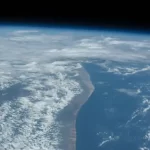Melting mountain glaciers poses an increased risk of flooding for about 15 million people around the world, with communities in Asia facing the greatest risk, researchers said in a new report.
Runoff from melting glaciers often collects in shallow lakes, blocked by rocks and debris. The risk comes when a lake overflows, rushing through its natural barrier and sending a torrent of water rushing into mountain valleys.
Scientists have assessed for the first time how many people are at risk from these floods globally, and found that more than half of the population at risk live in India, Pakistan, China and Peru.
In a study published in the journal Nature Communications, they stated that the risk is highest when a large number of people live near a lake.
Stuart Dunning, a physical geographer at the University of Newcastle and a co-author of the study, said: “Our work is not just focused on the size or number of glacial lakes – there is no natural disaster – it is the presence of people, especially vulnerable people, in the landscape that causes glaciers. disaster”.
Glacial lake floods are expected to get worse in a warming climate. Collectively, the world’s glaciers lost about 332 gigatonnes of ice per year between 2006 and 2016. Since 1990, the number and size of glacial lakes worldwide has increased by about 50%.
In the high mountains of Asia, about 9 million people live near more than 2,000 glacial lakes. In 2021, more than 100 people perished in India in a flood in its northern mountains.
Himalayan heating
Compared to mountain glaciers in the Alps and North America, icy places in Asia are less well-watched—most lack long-term monitoring of how they change over time.
The most studied Himalayan glacier is the Chhota Chigri in northern India, which has 20 years of mass balance measurements — the difference between how much ice a glacier gains and loses in one year.
In 2022, India experienced extreme heat, and near the end of the year, scientists headed to the Himalayas to measure the mass of Chhota Shigri.
Their findings revealed that the most studied Himalayan glacier had its worst year on record. Chhota Shigri lost three times more mass in 2022 compared to its annual average from 2002 to 2022.
“The effects are already visible because the glacier is weakening and retreating,” said Dr. Farooq Azam, a glaciologist at the Indian Institute of Technology Indore who is monitoring Chota Chigri, adding that this will be “affecting the water availability downstream in the near future.”
Satellite observations also show that the Himalayan glaciers are in a general state of decline.
“The ice is already melting significantly over the past decades — mass loss is accelerating,” said Tobias Pölsch, a glaciologist at the Graz University of Technology in Austria.
From 1990 to 2015, coverage of Himalayan glaciers shrank by about 11%, according to a July 2022 study.
During the same time period, Himalayan glacial lakes increased by about 9% in number, and 14% in area. More than 200 lakes now pose a very high risk to Himalayan communities, according to 2022 research.











